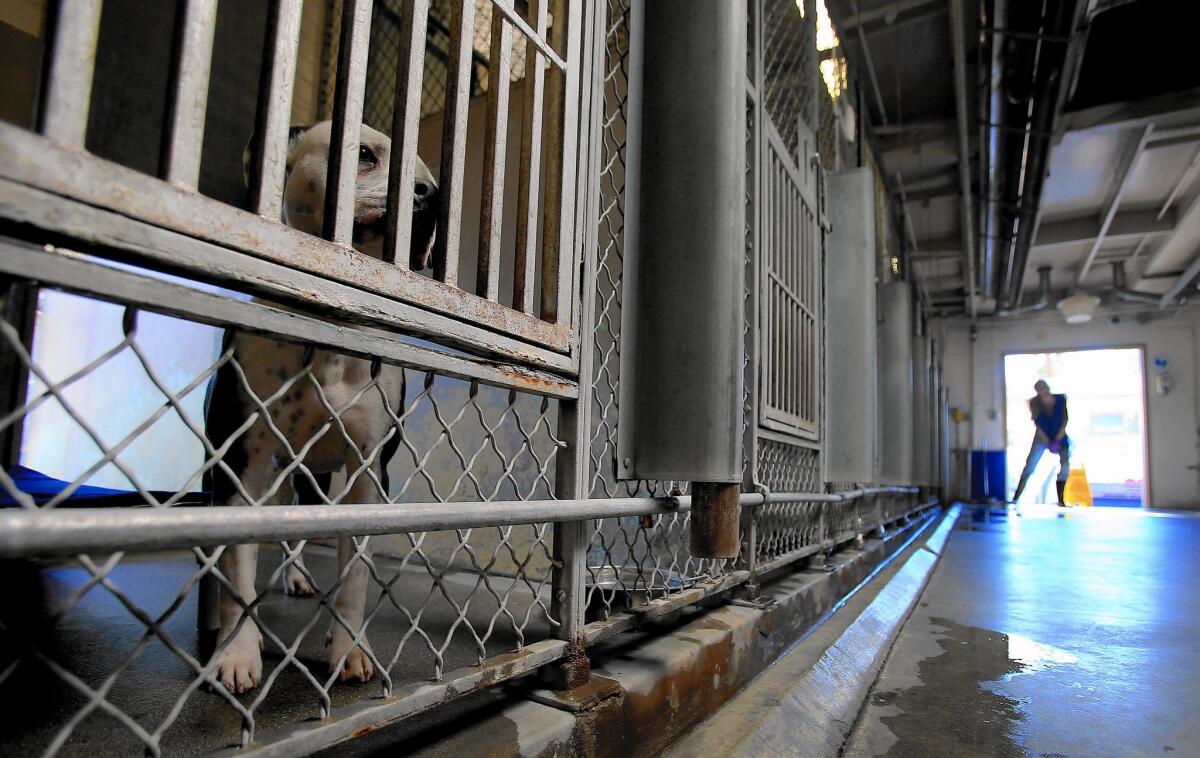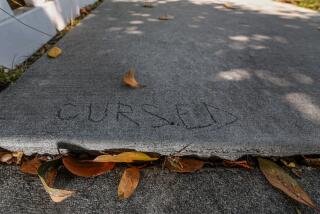L.A. leaders’ lofty goals are at odds with reality

We’re going to house every homeless veteran by the end of this year. We’re going to stop killing dogs and cats in animal shelters by 2017. And we’re going to eliminate traffic fatalities by 2035.
Really, Los Angeles?
You can call me a cynic, but I’m tired of high-minded claims that aren’t backed up by sound and realistic plans.
Feel-good promises and grand intentions do not a vision make. They just obscure the messy details and costly trade-offs of complicated problems.
Take the new plan for traffic management, approved by the City Council last week.
It’s motivated by great intentions: Making streets safer for bicycle riders and pedestrians. Reducing traffic fatalities. But its language is detached from reality. It’s a “mobility” plan that will use “traffic calming” measures to put streets on a “road diet.”
Translation: It will take traffic lanes away from cars and devote them to buses and bikes.
I’m not saying that’s a bad thing. I take public transit to work when I can and ride my bike to run errands when the Valley isn’t sweltering.
But there’s nothing “calming” about crawling bumper-to-bumper down a street whose “road diet” has reduced it from two lanes to one. And that won’t improve the “mobility” of residents on quiet side streets that become Waze shortcuts for impatient motorists.
::
Politics aside, there’s a reason public campaigns like these are couched in absolutes: No more traffic fatalities, homeless veterans or animals put to death in crowded shelters.
“To rally people around something, you have to promise that you’re taking out all the risks,” said USC psychology professor Norbert Schwarz. “When you say the risk will be a little less likely if they do this, that’s not a goal that is highly motivating.”
We cheer the “no more” slogan, even if we suspect the claim is patently untrue.
“That suggests that if you’re a politician, you can get more people to support the cause if you make these outlandish promises,” Schwarz said. “At the same time, you’re setting yourself up for failure.”
Failure that won’t matter 20 years from now — when there’s a new City Council and we’re all riding around in self-driving cars.
I get the idea of thinking big; a grandiose goal can be a motivator.
The number of dogs and cats euthanized in Los Angeles shelters has dropped significantly since the city’s “No Kill” campaign began. That’s because it became a collaborative effort, with private animal rescues doing much of the heavy lifting: finding homes for unwanted dogs and cats, keeping animals out of shelters by supporting their owners and providing low-cost spay and neuter services.
Yet more than 11,000 cats and dogs had to be put to death in the last year because shelters were squeezed for space. That’s a long way from the promise of “Save Them All.”
::
There are upsides to the sloganeering.
It’s a measuring stick we can use to hold our city and ourselves accountable. It’s a way of making progress on tough problems that might never be totally resolved.
I’m trying to learn to dial down my expectations when I hear “no more.”
Last year, Mayor Eric Garcetti pledged to house every homeless veteran in Los Angeles by the end of 2015. There have been a few bumps in the road since then — including the fact that hundreds of veterans with housing vouchers can’t persuade landlords to accept the subsidies. But more than 3,300 have already been housed — about half the number estimated to have been living on the streets.
“Pragmatically, predictably, there isn’t going to be a situation where there’s no veteran without a home by the end of the year,” said attorney Gary Blasi, part of a Public Counsel Opportunity Under Law team that helped negotiate a federal settlement aimed at ending veteran homelessness.
“But setting the goal is a terrific starting point,” he said. “It helps the process, it produces pressure.... It’s like having a goal for losing weight. I don’t know any other way to do it.”
Still, that goal can backfire as a political tactic if officials don’t check the scale from time to time and let the public know where the project stands.
“If you say you’re going to do this and you fall far short,” Blasi said, “that can lead to a kind of cynicism that these things don’t mean anything.”
It’s up to us to hold the mayor and his minions accountable. Because a goal sounds like a promise when a politician makes it.
Twitter: @SandyBanksLAT
More to Read
Sign up for Essential California
The most important California stories and recommendations in your inbox every morning.
You may occasionally receive promotional content from the Los Angeles Times.











